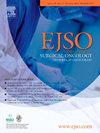Extensive cytoreductive surgery in stage IV ovarian cancer may not be a justified treatment strategy
IF 2.9
2区 医学
Q2 ONCOLOGY
引用次数: 0
Abstract
Background
Complete macroscopic surgical cytoreduction improves survival in advanced ovarian cancer. However, our previous results suggest that the survival benefits of aggressive surgery to achieve complete macroscopic resection may vary across different subgroups. This study aimed to identify a potential poor-prognosis subgroup among patients with complete macroscopic resection.
Patients and methods
This cohort study included all patients with advanced ovarian cancer who underwent complete macroscopic resection in a public and centralized health care system setting. Two 3-year cohorts were compared: pre-implementation (cohort 1, n = 101) and post-implementation (cohort 2, n = 172) of a very high surgical proficiency setting. Overall survival was compared by relative risks (RR) stratified by stage and surgical extent. Cox regression estimated hazard ratios (HR) adjusted for relevant covariates.
Results
In patients with stage IV, median survival was 33 (cohort 2) vs 47 months (cohort 1), 7-year RR 1.01 (95 % CI 0.78 to 1.31). When extensive surgery was required in stage IV median survival was 27 (cohort 2) vs 58 months (cohort 1), 5-year RR 0.91 (95 % CI 0.81 to 1.01).
By contrast, in stage III, median survival was 93 (cohort 2) vs 59 (cohort 1) months, 7-year RR 0.76 (95 % CI 0.59 to 0.98), with the greatest difference when less extensive surgery was required; Not reached vs 65 months, 7-year RR 0.62 (95 % CI, 0.43 to 0.88). Adjusted analysis confirmed improved survival in cohort 2 only after less extensive surgery, HR 0.56 (95 % CI, 0.33–0.95).
Conclusion
The implementation of a very high surgical proficiency setting was not associated with improved survival in patients with stage IV despite complete macroscopic resection, as opposed to patients with stage III.
广泛的细胞减少手术在第四期卵巢癌可能不是一个合理的治疗策略
背景:完全的肉眼手术细胞减少术可提高晚期卵巢癌患者的生存率。然而,我们之前的结果表明,在不同的亚组中,通过积极手术实现完全宏观切除的生存益处可能有所不同。这项研究的目的是确定一个潜在的预后不良亚组的患者完全肉眼切除。患者和方法本队列研究包括所有在公共和集中医疗保健系统中接受完全宏观切除的晚期卵巢癌患者。比较了两个3年队列:实施前(队列1,n = 101)和实施后(队列2,n = 172)非常高的手术熟练程度设置。总生存率通过分期和手术范围分层的相对危险度(RR)进行比较。Cox回归估计校正相关协变量后的风险比(HR)。结果IV期患者的中位生存期为33个月(队列2)vs 47个月(队列1),7年RR为1.01 (95% CI 0.78 ~ 1.31)。当IV期需要广泛手术时,中位生存期为27个月(队列2)vs 58个月(队列1),5年RR为0.91 (95% CI 0.81至1.01)。相比之下,在III期,中位生存期为93个月(队列2)vs 59个月(队列1),7年RR 0.76 (95% CI 0.59至0.98),当需要较少的广泛手术时差异最大;未达到vs 65个月,7年RR 0.62 (95% CI, 0.43 - 0.88)。校正分析证实,队列2仅在较少范围的手术后改善了生存率,风险比为0.56 (95% CI, 0.33-0.95)。结论:与III期患者相比,尽管IV期患者进行了完全的宏观切除,但实施非常高的手术熟练程度并没有提高IV期患者的生存率。
本文章由计算机程序翻译,如有差异,请以英文原文为准。
求助全文
约1分钟内获得全文
求助全文
来源期刊

Ejso
医学-外科
CiteScore
6.40
自引率
2.60%
发文量
1148
审稿时长
41 days
期刊介绍:
JSO - European Journal of Surgical Oncology ("the Journal of Cancer Surgery") is the Official Journal of the European Society of Surgical Oncology and BASO ~ the Association for Cancer Surgery.
The EJSO aims to advance surgical oncology research and practice through the publication of original research articles, review articles, editorials, debates and correspondence.
 求助内容:
求助内容: 应助结果提醒方式:
应助结果提醒方式:


